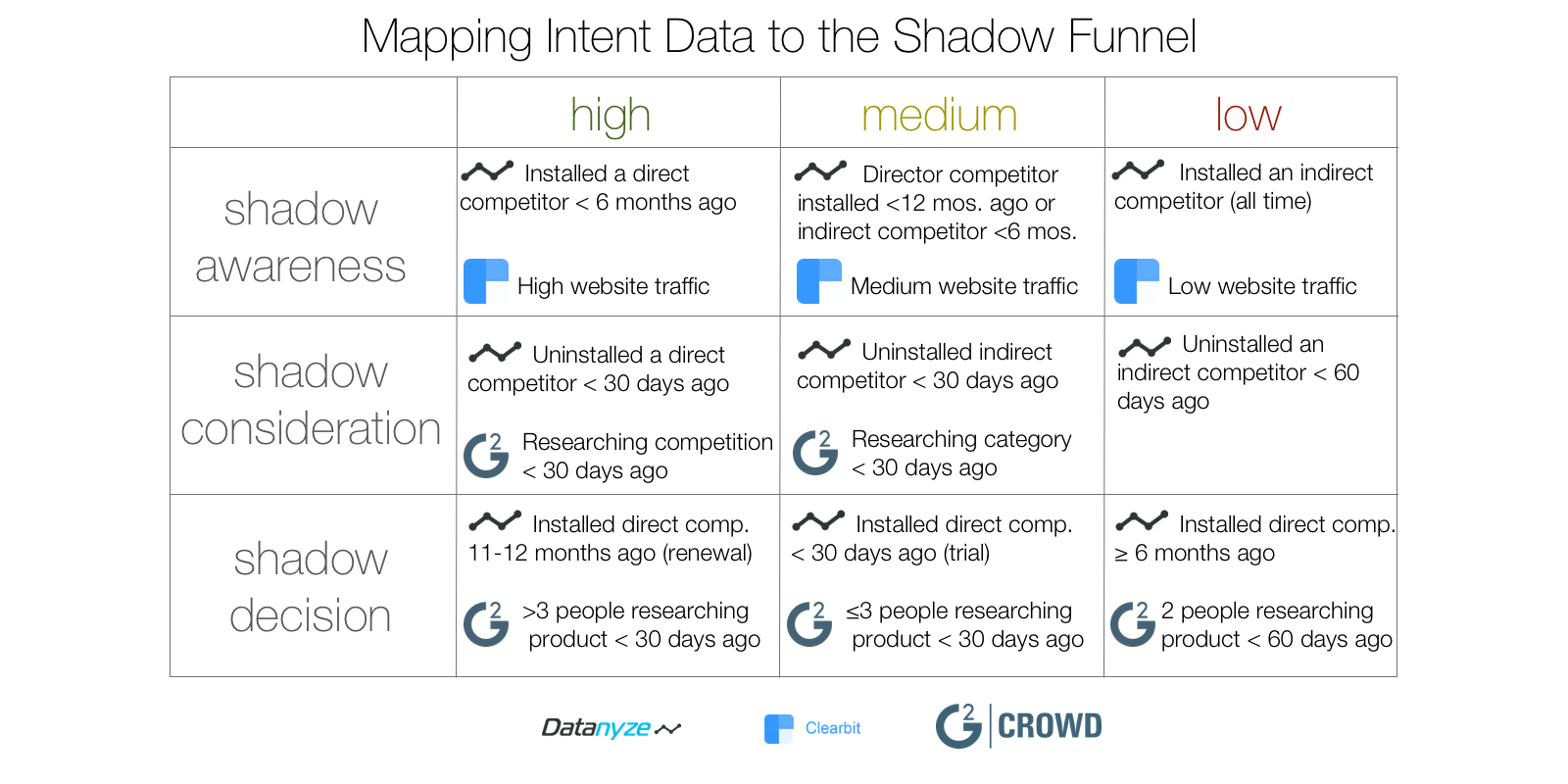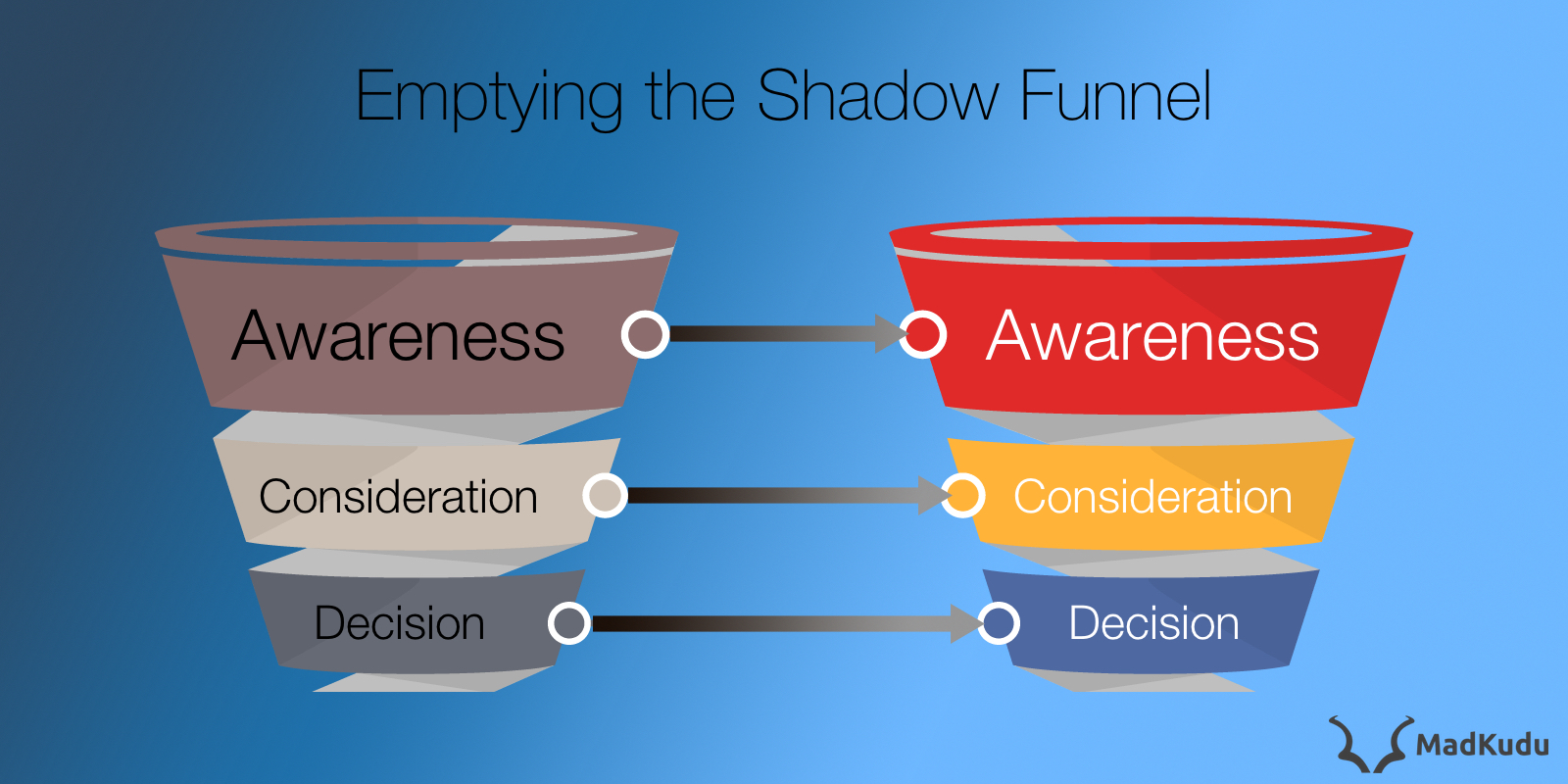
Building a Shadow Funnel

Marketing is becoming an engineer’s game. Marketing tools come with Zapier integrations, webhooks and APIs. Growth engineers finely tune their funnel, each new experiment - an ebook, a webinar, ad copy or a free tool - plugging into or improving upon the funnel.Growth engineers fill their top of their funnel by targeting prospects who look like they are a good fit for their product, but haven’t engaged yet. Guillaume Cabane, VP Growth at Drift, has been sharing his experiments leveraging intent data for years. Intent data allow Guillaume to discern the intentions of potential buyers by providing key data points into what they are doing or thinking about doing.
A quick review of the three main categories of Intent Data
- Behavioral Intent: This includes 1st party review sites like G2Crowd, Capterra & GetApp, as well as Bombora, which aggregates data from industry publications & analysts. They provide Drift with data about which companies are researching their industry, their competitors, or Drift directly. (e.g: “Liam from MadKudu viewed Drift’s G2Crowd Page”)
- Technographics: Datanyze, HGData & DemandMatrix provide data about companies that are installing & uninstalling technologies, tools or vendors (e.g: “MadKudu uninstalled Drift 30 days ago:)
- Firmographics: Clearbit, Zoominfo & DiscoverOrg offer data enrichment tools starting from a website domain or email, providing everything from headquarter location to employee count.
In a standard buyer journey, the right message and medium depends on where a prospect is in the funnel:
- Awareness: do they know about the problem you solve?
- Consideration: are they evaluating how to solve a problem?
- Decision: are they evaluating whether to use you to solve their problem?
Drift began looking at whether we could help them determine the next best action for every prospect and account in their total addressable market (TAM). TAM can be calculated as the sum of all qualified prospects who have engaged with you (MQLs) + all qualified prospects who have not engaged with you.
TAM = MQLs + SMQLs
I'll call the latter Shadow MQLs (SMQLs), more precisely defined as any prospect that is showing engagement in your industry or in one of your competitors, but not you. Drift already leveraged MadKudu to determine when & how to engage with MQLs in their funnel, but they needed to automate the next best action for SMQLs. Should a sales person call them? Or should Drift send them a personalized gift through Sendoso? Our strategy for determining the next best action involved mapping intent data to the standard buyer journey stages. By doing this, we could build what I call a Shadow Funnel. For this experiment, we focused on four intent data providers:
- G2Crowd: a review site that helps buyers to find the perfect solution for their needs. They send Drift data about who is looking at their category (live chat) or Drift’s page.
- SEMRush: a tool that provides information about the paid marketing budget of accounts.
- Datanyze: this gives us information about what tech are being used on websites.
- (Clearbit) Reveal: tells us the accounts that are visiting our website.
In order to build our shadow funnel, we need to define Shadow stages of the buyer journey:
- Awareness: understands the industry you operate in.
- Consideration: looking at specific vendors (not you).
- Decision: evaluating specific vendors (not you).
MadKudu's role in this funnel is to determine whether the SMQL is showing High, Medium, or Low predicted conversion. Here is a table illustrating the data points we mapped to each stage & fit level:

By matching Datanyze & G2Crowd data, for example, Drift can identify accounts who have uninstalled one of Drift's competitors in the past 30 days and have begun researching the competition. Without ever visiting a Drift property (which would, in turn, enter them into Drift's real funnel), MadKudu predicts a high probability that this account is in the process of considering a new solution in their space. With a traditional funnel, the goal is to fill it and optimize for conversion down-funnel. Awareness campaigns drive traffic, acquisition campaigns drive email capture, and conversion campaigns increase sales velocity & conversion. The goal of the Shadow Funnel is the opposite. Drift wants the funnel to be empty and to have everyone who is in it churn out. Rephrasing our previous TAM equation, we can state the following:
TAM = Funnel + Shadow Funnel
Anyone who is in your TAM that isn’t in your funnel is in your Shadow Funnel, and anyone who is in your TAM that isn’t in your Shadow Funnel is therefore in your Funnel. The goal then becomes to move horizontally:
- we want Shadow prospects to move from Shadow Aware (i.e: aware of the industry) to Aware (of you).
- we want prospects at the Shadow Decision stage (i.e: deciding which tool to use, that isn’t yours) to move to the Decision phase (i.e: deciding whether or not to use you).
- And so on.

Once you know where your target audience is in the buyer process, you can deliver targeting messaging to pull them from the Shadow Funnel into your funnel.

Next Steps: evaluating intent as predictive behavior.
For now, the Shadow Funnel is a proof of concept. Through this method, Drift identified 1,000+ new qualified accounts to engage with. Once we have some historical data to play with, our next step will be to build a model to determine which intent data sources are best at predicting Shadow Funnel conversion. We'll also want to look at which engagement methods show the most promise. Can the same engagement tactics that work on the traditional funnel work on the Shadow Funnel? Does the thought leadership retargeting ad on LinkedIn have the same impact if an account has never engaged with you before? Does looking at a category on G2Crowd reliably predict whether you’re interested in considering our product?We are excited to continue to explore this with Drift and other SaaS companies leveraging intent data to engage qualified prospects who need their product before prospects engage with them. This is a natural evolution of the B2C strategies that eCommerce & travel companies have been employing in previous years, but tailored towards helping companies looking for answers get those answers faster. https://twitter.com/guillaumecabane/status/1075861864653836288 We’ll be talking more about this strategy with Drift & Segment on our upcoming webinar here.
